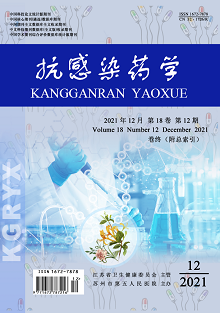CAO Hu-shan, JI Shou-peng, LIU Xin-zheng
Objective: To investigate the distribution characteristics and drug resistance of carbapenem-resistant Klebsiella pneumoniae (CRKP) in hospitals of Luohe district from 2017 to 2020. Methods: The detection data of 4 652 strains of Klebsiella pneumoniae (KP) isolated from Luohe Regional Hospital from January 2017 to December 2020 were collected, and the clinical detection rate of CRKP, specimen source, department distribution and drug resistance characteristics of CRKP in KP strains during the 4 years were analyzed. Results: In 4 652 strains of KP, the detection rate of CRKP was 9.42%. In 2017, 1 053 strains of KP were isolated, and 86 strains of CRKP were detected, accounting for 8.17%. In 1 079 strains of KP isolated in 2018, 102 strains of CRKP were detected, accounting for 9.45%. In 2019, 1 126 strains of KP were isolated, and 110 strains of CRKP were detected, accounting for 9.77%. In 2020, 1 394 strains of KP were isolated, and 140 strains of CRKP were detected, accounting for 10.04%. The samples were mainly from respiratory secretions (36.53%), followed by urine (24.20%), blood (16.21%), sputum (13.70%), wound secretions (7.31%) and others (2.05%). CRKP was detected mainly in ICU (36.76%), followed by emergency department and respiratory department (14.16%),geriatrics department (11.87%), urology department (10.50%), liver surgery department (6.16%), pediatrics department (5.48%) and cardiology department (0.91%). Drug sensitivity results showed that the drug resistance rates of CRKP to ceftriaxone, tigecycline and polymyxin B were relatively low (46.58%,47.95% and 15.07%,respectively), while the drug resistance rates of CRKP to aztreonam, levofloxacin, ciprofloxacin, ceftazidime and cefepime were all more than 80.00%. The drug resistance rates to ampicillin, piperacillin-tazobactam and imipenem were 100.00%. Conclusion: The detection rate of CRKP in hospitals in Luohe district increased year by year, mainly distributed in ICU, and the main specimens were from respiratory secretions. In addition, CRKP is highly resistant to commonly used antibacterials, so clinical monitoring of bacterial resistance should be strengthened, and antibiotics with high sensitivity rate should be selected based on drug sensitivity results to ensure the effectiveness of treatment for patients.
